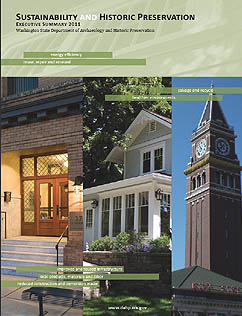Sustainability
 Historic Preservation and Sustainability are natural partners. Preservation and reuse of historic buildings reduces resource and material consumption, puts less waste in landfills, and consumes less energy than demolishing buildings and constructing new ones. Over the past decade, advances in high performance or “green” buildings have been numerous, but primarily have focused on new construction. As a result, the preservation and adaptability of historic and older buildings has not always been at the forefront of the ‘green’ movement agenda. However, this is changing. Historic buildings, often energy efficient from inherent characteristics, can be upgraded with new technologies to maximize energy performance. Historic features such as windows can be repaired and restored for higher efficiency. In addition to saving existing resources and historic character, historic preservation means environmental, cultural and economic benefits for Washington communities.
Historic Preservation and Sustainability are natural partners. Preservation and reuse of historic buildings reduces resource and material consumption, puts less waste in landfills, and consumes less energy than demolishing buildings and constructing new ones. Over the past decade, advances in high performance or “green” buildings have been numerous, but primarily have focused on new construction. As a result, the preservation and adaptability of historic and older buildings has not always been at the forefront of the ‘green’ movement agenda. However, this is changing. Historic buildings, often energy efficient from inherent characteristics, can be upgraded with new technologies to maximize energy performance. Historic features such as windows can be repaired and restored for higher efficiency. In addition to saving existing resources and historic character, historic preservation means environmental, cultural and economic benefits for Washington communities.
Sustainability Reports
Solar Resources
- Installing Solar Panels on Historic Buildings
- Solar Panels on Historic Properties - NPS Preservation Tech Bulletin
- Solar Technology - NPS Illustrated Guidelines on Sustainability for Rehabilitating Historic Buildings
- Incorporating Solar Panels in a Rehabilitation Project - NPS
- Implementing Solar SV Projects on Historic Buildings and in Historic Districts - National Renewable Enrgy Lab
- Energy Efficiency and Historic Buildings - Historic England
- The Latest on Solar Roofs, Solar Shingles and Solar Tiles - NAPC
- Installing Solar Panels on Historic Buildings: A Survey of the Regulatory Environment
- "Old Meets New: The Debate Over Photovoltaics in Historic Districts" - Architect Mag
- Solar Washington - Non-Profit Advocacy Group
- Renewable Energy Incentives - WA State Utilities & Transportation Commission
- Analysis and Simulation of Performance Data for Residential Solar Heating - Seattle, 1978
- Solar Radiation in the Pacific Northwest - 1979
Legislation - Clean Buildings Performance Standard
- General info on Clean Buildings Performance Standard (CBPS)
- HB 1257 - Engery Efficency BIll (not provision to protect character defining features of histric properties)




